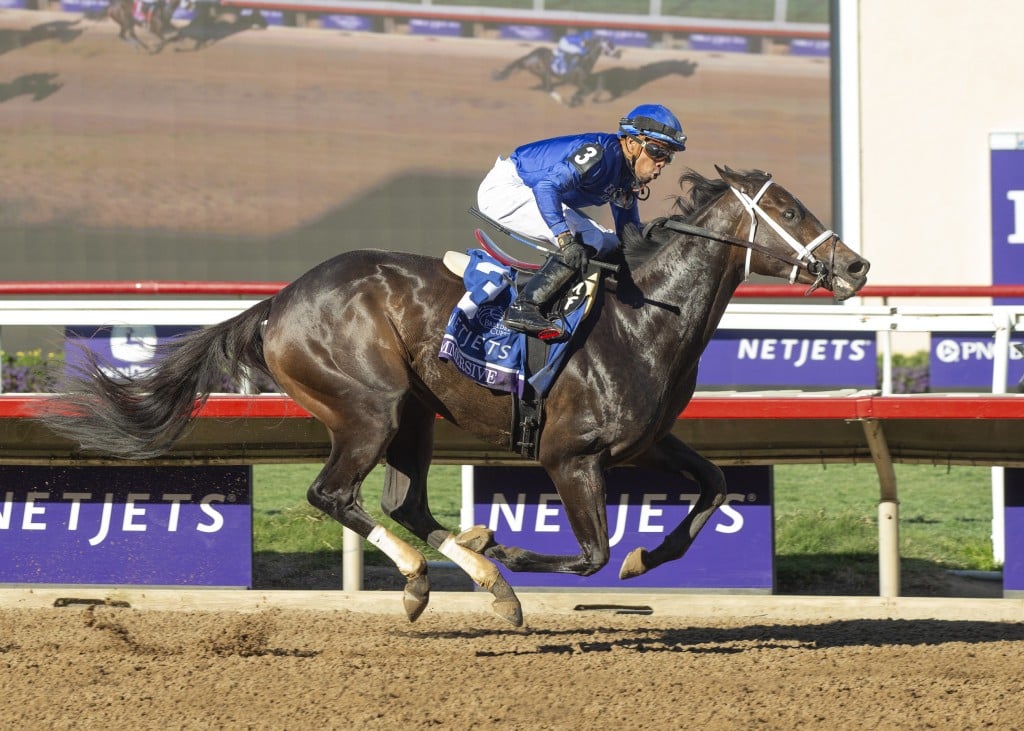

The $2 million Breeders’ Cup Juvenile Fillies (G1) is one of the original seven races that have been run each year since the inaugural event at Hollywood Park in 1984.
It is the main event in deciding who will win the Eclipse Award as champion 2-year-old filly, and of the 39 winners of the race, 35 have earned the year-end championship honor, including Wonder Wheel a year ago. It was worth $1 million until 2005.
Of the four Eclipse Award winners who didn’t win the Breeders’ Cup Juvenile Fillies, one finished first but was disqualified (She’s A Tiger in 2013 was placed second behind Ria Antonia for interference in the stretch). The others -- Chilukki (1999) and Family Style (1985) were both second in this race, while Golden Attraction (1985) was third. Champion Outstandingly in 1984 finished second in the Breeders’ Cup but was elevated to the win after the disqualification of rival Fran’s Valentine.
Only two winners of this race -- Open Mind (1988) and Silverbulletday (1998) – have gone on to wear the lilies by winning the Kentucky Oaks (G1) the following year, and both were also crowned champion 3-year-old filly. Others to have won dual championships include Go For Wand (1989, 1990), Beholder (2012, 2013), and Songbird (2015, 2016). Beholder, who was also champion older female in 2015 and 2016, won the Breeders’ Cup Distaff (G1) in 2013 and 2016.
Trainer D. Wayne Lukas owns the record for most winners with six (1985, Twilight Ridge; 1988, Open Mind; 1994, Flanders; 1999, Cash Run; 2005, Folklore; and 2014, Take Charge Brandi). Mike Smith (2008, Stardom Bound; 2015, Songbird; and 2017, Caledonia Road) and Joel Rosario (2018, Jaywalk; 2020, Vequist; and 2021, Echo Zulu) lead all jockeys with three wins each. Seven others are tied with two wins each on their resumes.
Stardom Bound holds the record at this distance, clocking 1:40.99 in 2008.
2006 -- Dreaming of Anna captured the title with a dominant wire-to-wire performance in the only Breeders’ Cup held outside the United States when it was contested at Woodbine. She was crowned champion 2-year-old filly.
1999 – Silverbulletday staged a breathtaking display in the 1999 Breeders’ Cup Juvenile Fillies at Gulfstream Park, where she delivered a performance that remains etched in racing history. After a slow start, she showcased her immense talent by rallying from behind and winning by an impressive 3 ½ lengths.
2012 – Beholder made her mark in the 2012 Breeders’ Cup Juvenile Fillies at Santa Anita Park in a performance that left fans and bettors alike in awe. Starting from a challenging position, Beholder overcame a slow start to take command in the final stretch, finishing with an intense burst of speed to secure her victory by 4 ½ lengths. This race was pivotal, as it laid the groundwork for Beholder's illustrious career, during which she would compete against and defeat some of the toughest rivals in horse racing history, including males.
2013 -- Ria Antonia actually finished second but was promoted to first after rival She’s a Tiger, who crossed the wire in front, bumped her down the lane. The DQ was the second in Breeders’ Cup history and, ironically, the second in the Breeders’ Cup Juvenile Fillies. Fran’s Valentine was demoted from her win in 1984.
2015 – Songbird is often regarded as one of the greatest fillies of her generation, and her performance in 2015 at Keeneland was a testament to her talent. Starting the race with powerful precision, she quickly gained the lead and maintained it with confidence, ultimately winning by a comfortable 5 ¾ lengths. Her victory displayed a combination of speed and intelligent racing, marking her as a must-watch contender for future races and a strong favorite among bettors.
As one of the original seven Breeders’ Cup races, a total of 461 have started in the race for an average field size of 11 runners. The fullest field is 14, the smallest was six, and the average mutuel payout is $20.44. However, only about 23% of winners pay more than $20 on a $2 wager.
There have been huge upsets; the highest win price recorded was the $125.40 Take Charge Brandi returned in 2014.
Interestingly, the Juvenile Fillies is a relatively “chalky” Breeders’ Cup race. The post-time favorite has won at a higher rate than many other Breeders’ Cup races. The favorites’ strike rate in the Juvenile Fillies is 45%. However, in more recent years, the dominance of favorites has cooled: in the past 13 years, the favorite has won only three times.
Early pace is a strong positive. Over past runnings, about 54% of winners have been on or within two lengths of the lead in the early part of the race; another 31% raced two to five lengths off the pace; true closers (from far back) make up only 15% of winners.
In Southern California specifically, front-runners have had particular success (winning at a 57% clip).
In looking at the last 10 runnings, seven out of the 10 winners were first, second, or third after the opening half-mile.
When it comes to betting, the Breeders' Cup Juvenile Fillies offers unique opportunities. The average payout to the winner can fluctuate significantly from year to year, influenced by bettors' preferences and the perceived strength of the competitors. For instance, in recent years, favorites have often produced lower payouts, while longshots can yield eye-popping returns.
Bettors should keep in mind some key trends when approaching the Juvenile Fillies.
Pay close attention to the training patterns leading up to the event; those coming from respected trainers often perform better. Moreover, many successful bettors observe the breeding of the horses. Pedigree plays an essential role, as fillies with strong bloodlines tend to have the innate ability and talent to compete at a high level. Watching for horses by well-known sires can lead to smarter betting choices.
Bets suggest that there’s a “valley” of underperformance by mid-range longshots: horses in the 7-1 to 17-1 range rarely win. The winning tickets tend to come from either solid favorites or big longshots.
Experience counts, too. Fillies with prior Grade 1 experience tend to have an edge. In fact, in recent decades, almost all Juvenile Fillies winners had raced in G1 races before.
The Frizette Stakes (G1) in New York is a powerful prep; many Juvenile Fillies winners ran in the Frizette. Other productive preps include the Alcibiades (Keeneland) and Del Mar Debutante.
Certain jockeys have done well, so paying attention to past successes is important. Joel Rosario and Mike Smith lead all riders with three wins each.
Given the historically strong strike rate of favorites in this race, backing a sound favorite is often defensible. But “junk favorites” or lightly tested ones are riskier.
Because midrange odds rarely win, the most attractive underdog plays are either real live longshots or solid contenders, not the “middling” odds horses.
Horses that can stay within the top four early are advantaged, especially over 1⅛ miles with early fractions.
Track whether a particular rider or trainer has a history with the race or with 2-year-olds under pressure.
Because favorites dominate often, but exotics pay big when upsets happen, layered betting (boxing, keying) is frequently the way to go.


The writing team at US Racing is comprised of both full-time and part-time contributors with expertise in various aspects of the Sport of Kings.























